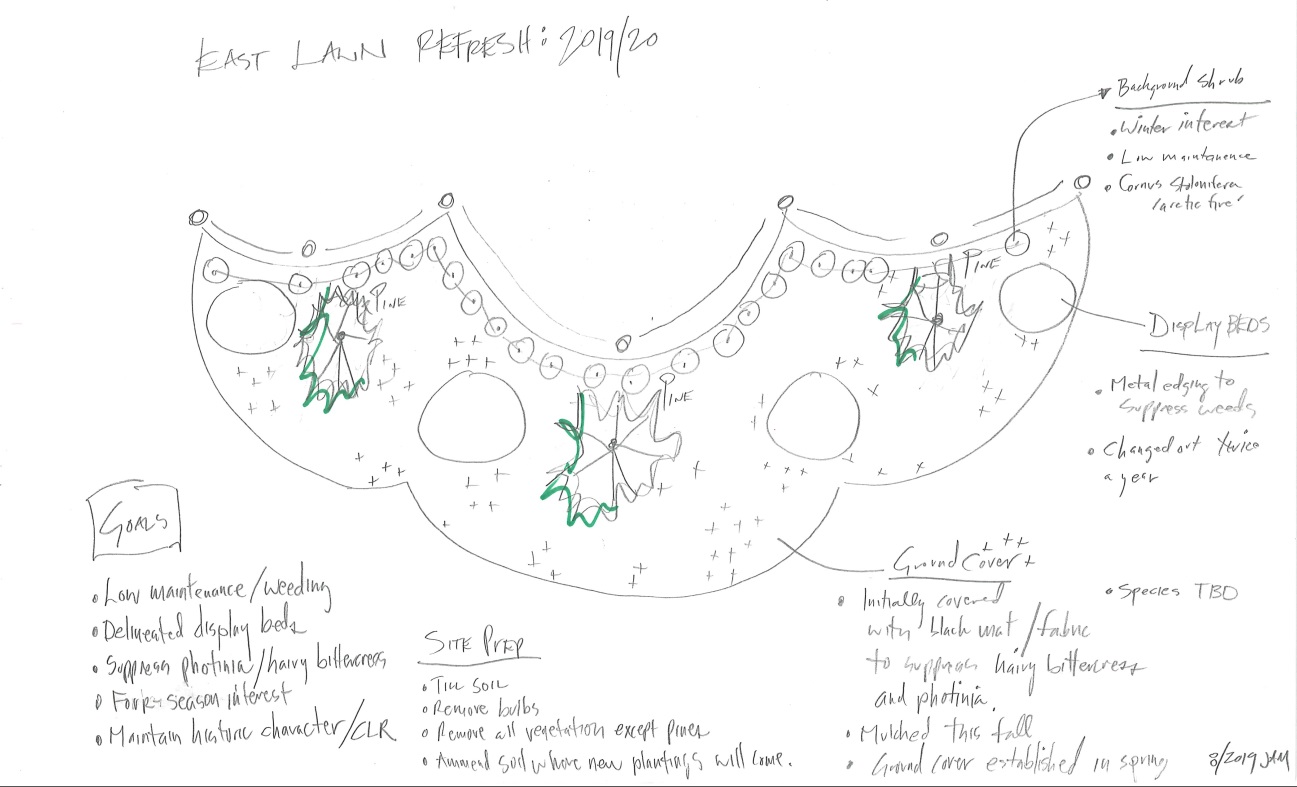For this post I’d like to share the process and rationale of upgrading one of our garden beds at Tudor Place.
Our East Lawn bed is a large planting border situated along the eastern edge of the East Lawn garden. This area, along with several other spaces and garden rooms, comprises of the formal North Gardens of Tudor Place. It is a key functional space for us. We use the space for events and programming such as weddings and outdoor classroom space. The formal gardens are enhanced by strong axis and sight lines that terminate at this bed, telling us that this space was designed to be an important focal point. The Tudor Place grounds are significant as a vernacular landscape by the owners who shaped the landscape over several generations from 1805 to 1983. It has undergone many changes during this time. My job at Tudor Place is to leverage our records to understand the cultural landscape of this space for accurate interpretation and curation. Additionally, we aim to pursue preservation techniques ensuring that the space is representative of how the family shaped the space over time. Finally, we take liberties for updating spaces to accommodate Tudor Place activities. This could be widening paths or bringing more attention to beautification.
Here’s a timeline of the East Lawn garden area:
- Mesic Hardwood Forest Ecological System [tulip tree, beech, white oak, and holly] shaped by native Algonquian people called the Nacotchtank.
- Mid-Late 1700s: Area cleared and settled by Europeans
- Early 1800s: Orchard with peach trees
- Late 1800s: area along east perimeter converted to a tennis lawn. Tudor Place Lawn Tennis Club founded in 1888.
- Early 1900s: Tennis Lawn removed
- 1930s: Area was improved with perimeter plantings to screen out surrounding properties.
- Area now preserved to 1930-1983 time period.

The Challenges
As an important space that sees a lot of visitor traffic, many attempts have been made over the years to beautify the site. Thankfully, the burning bush hedge row was removed sometime after 2012 to expose the historic chestnut woven fence. Most recently all of the english ivy groundcover was removed in favor of a mixture of native plumbago and violets. In a world with so much english ivy, I think this strategy was worth trying, but ultimately failed. The plumbago and violets were not able to establish quickly enough and other more aggressive plants [weeds and invasives] moved in. Annoying weeds such as hairy bittercress and aggressive plants such as photinia get an early spring start before the plumbago and can never catch up. The result is a constant weeding effort to make the bed look good.

Additionally, hundreds of spring bulbs were planted in the bed a few years ago. While the area looks stunning in the spring, unless the bulbs are removed the area looks shabby after the flowering and creates more pockets for weeds to infiltrate. This reason alone is why most public gardens operating a display bed rotate out the bulbs after flowering each spring.

Overall, the main goal was create an attractive, low maintenance space with great seasonal interest. We want to limit the amount of man hours devoted to maintaining this space.

The Solution
To achieve this goal, we needed a plan to stop the photinia and stop the hairy bittercress. Weed block matting was to be placed down over the entire area for at least 1 full season to stop the cycle of the hairy bittercress and to contain the photinia. The entire area is to be mulched. To address the desire for a seasonal interest display garden, four islands (or medallions) within the bed will be carved out with metal edging. These four sub-beds will then be planted seasonally. To generate some winter interest, red twig dogwood will be planted in a line against the fence. The material will also be used for winter wreath making workshops.


Conclusions
Last week we put all the weed block and mulch down and created the medallion display beds. Mums are going in for the fall! I’m looking forward to following up with this in the spring
